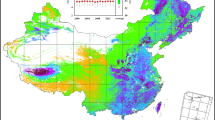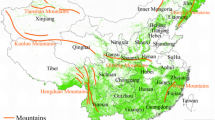Abstract
The dynamics of agricultural and forestry biomass are highly sensitive to climate change, particularly in high latitude regions. Heilongjiang Province was selected as research area in North-east China. We explored the trend of regional climate warming and distribution feature of biomass resources, and then analyzed on the spatial relationship between climate factors and biomass resources. Net primary productivity (NPP) is one of the key indicators of vegetation productivity, and was simulated as base data to calculate the distribution of agricultural and forestry biomass. The results show that temperatures rose by up to 0.37°C/10a from 1961 to 2013. Spatially, the variation of agricultural biomass per unit area changed from -1.93 to 5.85 t·km–2·a–1 during 2000–2013. More than 85% of farmland areas showed a positive relationship between agricultural biomass and precipitation. The results suggest that precipitation exerts an overwhelming climate influence on agricultural biomass. The mean density of forestry biomass varied from 10 to 30 t·km–2. Temperature had a significant negative effect on forestry biomass in Lesser Khingan and northern Changbai Mountain, because increased temperature leads to decreased Rubisco activity and increased respiration in these areas. Precipitation had a significant positive relationship with forestry biomass in south-western Changbai Mountain, because this area had a warmer climate and stress from insufficient precipitation may induce xylem cavitation. Understanding the effects of climate factors on regional biomass resources is of great significance in improving environmental management and promoting sustainable development of further biomass resource use.

Similar content being viewed by others
References
Shen W, Zou C, Liu D, Ouyang Y, Zhang H, Yang C, Bai S, Lin N. Climate-forced ecological changes over the Tibetan Plateau. Cold Regions Science and Technology, 2015, 114: 27–35
Liu C Y, Dong X F, Liu Y Y. Changes of NPP and their relationship to climate factors based on the transformation of different scales in Gansu, China. Catena, 2015, 125: 190–199
Poudel B C, Sathre R, Gustavsson L, Bergh J, Lundström A, Hyvönen R. Effects of climate change on biomass production and substitution in north-central Sweden. Biomass and Bioenergy, 2011, 35(10): 4340–4355
Gao Y, Zhou X, Wang Q, Wang C, Zhan Z, Chen L, Yan J, Qu R. Vegetation net primary productivity and its response to climate change during 2001–2008 in the Tibetan Plateau. Science of the Total Environment, 2013, 444: 356–362
Sun Y, Wang R, Liu J, Xiao L, Lin Y, Kao W. Spatial planning framework for biomass resources for power production at regional level: a case study for Fujian Province, China. Applied Energy, 2013, 106: 391–406
Hiloidhari M, Baruah D C. Rice straw residue biomass potential for decentralized electricity generation: a GIS based study in Lakhimpur district of Assam, India. Energy for Sustainable Development, 2011, 15(3): 214–222
I-Shin CHANG. Jing WU. Integration of climate change considerations into environmental impact assessment—implementation, problems and recommendations for China. Frontiers of Environmental Science&Engineering, 2013, 7(4): 598–607
Poulter B, Pederson N, Liu H, Zhu Z, D’Arrigo R, Ciais P, Davi N, Frank D, Leland C, Myneni R, Piao S, Wang T. Recent trends in Inner Asian forest dynamics to temperature and precipitation indicate high sensitivity to climate change. Agricultural and Forest Meteorology, 2013, 178–179: 31–45
Ma Z Y, Lin E D, Li N Y. Research review on the impact of climate change on China’s biomass energy. Chinese Meteorological Society. Guangzhou, 2007
Wang X Y, Zhou C Y, Jia Q Y. Impacts of climate change on forest ecosystems in Northeast China. Advances in Climate Chang Research, 2013, 4(4): 230–241(in Chinese)
Wei L, Yuting Y, Dongmei F. Aanlysis of spatial and temporal patterns of net primary production and their climate controls in China from 1982 to 2010. Agricultural and Forest Meteorology, 2015, 204: 22–36
Chunyu L, Xiaofeng D, Yingying L. Changes of NPP and their relationship to climate factors based on the transformation of different scales in Gansu, China. Catena, 2015, 125: 190–199
Wang W, Ouyang W, Hao F. A supply-chain analysis framework for assessing densified biomass solid fuel utilization policies in China. Energies, 2015, 8(7): 7122–7139
Giuntoli J, Agostini A, Caserini S, Lugato E, Baxter D, Marelli L. Climate change impacts of power generation from residual biomass. Biomass and Bioenergy, 2016, 03: 1–3
Lili Q, Tianzhu Z, Wei L. Assessing the potential of crop residue recycling in China and technology options based on a bottom-up model. Frontiers of Environmental Science & Engineering, 2014, 8 (4): 570–579
Banowetz G M, Boateng A, Steiner J J, Griffith S M, Sethi V, El-Nashaar H. Assessment of straw biomass feedstock resources in the Pacific Northwest. Biomass and Bioenergy, 2008, 32(7): 629–634
Lourinho G, Brito P. Assessment of biomass energy potential in a region of Portugal (Alto Alentejo). Energy, 2015, 81: 189–201
Dymond C C, Titus B D, Stinson G, Kurz W A. Future quantities and spatial distribution of harvesting residue and dead wood from natural disturbances in Canada. Forest Ecology and Management, 2010, 260(2): 181–192
Elmore A J, Shi X, Gorence N J, Li X, Jin H, Wang F, Zhang X. Spatial distribution of agricultural residue from rice for potential biofuel production in China. Biomass and Bioenergy, 2008, 32(1): 22–27
Gehrung J, Scholz Y. The application of simulated NPP data in improving the assessment of the spatial distribution of biomass in Europe. Biomass and Bioenergy, 2009, 33(4): 712–720
Wang Y, Cao S. Carbon sequestration may have negative impacts on ecosystem health. Environmental Science & Technology, 2011, 45 (5): 1759–1760
Qiao Z, Yang X, Liu J, Xu X. Ecological vulnerability assessment integrating the spatial analysis technology with algorithms: a case of the wood-grass ecotone of northeast china. Abstract and Applied Analysis, 2013, 2013(2): 900–914
Jin C X, Wang X R, Wang X, Hou K, Wang D. Variation trend and spatial distribution characteristics of precipitation in recent 50 years in Heilongjiang Province. Science of Soil and Water Conservation, 2015, 13(1): 76–83(in Chinese)
Hao F H, Wang W Y, Ouyang W, Luan Y. Impact of regional management alternatives and land conversion on the net primary productivity in Heilongjiang Province, China. Journal of Environmental Accounting and Management, 2016, 4(1): 43–56
Gao J, Liu Y. Climate warming and land use change in Heilongjiang Province, Northeast China. Applied Geography (Sevenoaks, England), 2011, 31(2): 476–482
Ren G Y, Guo J, Xu M Z, Chu Z Y, Zhang L, Zou X K, Li Q X, Liu X N. Basic characteristics of surface climate change in China during resent 50 years. Acta Meteeologica, 2005, 63(6): 942–956(in Chinese)
Gao J, Liu Y. Deforestation in Heilongjiang Province of China, 1896–2000: severity, spatiotemporal patterns and causes. Applied Geography (Sevenoaks, England), 2012, 35(2): 345–352
Fang S F, Yan J W, Che M L, Zhu Y, Liu Z, Pei H, Zhang H, Xu G, Lin X. Climate change and the ecological responses in Xinjiang, China: model simulations and data analyses. Quaternary International, 2013, 311: 108–116
Yu L L, Xia Z Q, Cai T, Guo L D. Variations of temperature, precipitation, and extreme events in Heilongjiang River. Procedia Engineering, 2011, 2012(28): 326–330
Li X, Cheng G, Lu L. Spatial analysis of air temperature in the Qinghai-Tibet Plateau. Arctic, Antarctic, and Alpine Research, 2005, 37(2): 246–252
Mahdian M H, Bandarabady S R, Sokouti R, Norouzi Banis Y. Appraisal of the geostatistical methods to estimate monthly and annual temperature. Journal of Applied Sciences, 2009, 9: 128–134
Aalto J, Pirinen P, Heikkinen J, Venäläinen A. Spatial interpolation of monthly climate data for Finland: comparison the performance of Kriging and generalized additive models. Theoretical and Applied Climatology, 2013, 112(1–2): 99–111
Hattis D, Ogneva-Himmelberger Y, Ratick S. The spatial variability of heat-related mortality in Massachusetts. Applied Geography (Sevenoaks, England), 2012, 33: 45–52
Li J J, Ren D M, Zhuang X. Evaluation Methods and examples of renewable energy and resource system. Journal of natural resources, 2001, 16(4): 373–380
Wang F. Study on Development Model of Biomass Energy Industry in Rural Areas of Heilongjiang Province. Northeast Forestry University, 2010
Benjamin P, Neil P, Hongya L, Zaichun Z, Rosanne D, Philippe C, Nicole D, David F, Caroline L, Ranga M, Shilong P, Tao W. Recent trends in Inner Asia forest dynamics to temperature and precipitation indicate high sensitivity to climate change. Agricultural and Forest Meteorology, 2013, 178: 31–45
Crabtree R, Potter C, Mullen R, Sheldon J, Huang S, Harmsen J, Rodman A, Jean C. A modeling and spatio-temporal analysis framework for monitoring environmental change using NPP as an ecosystem indicator. Remote Sensing of Environment, 2009, 113(7): 1486–1496
Gao Y, Yu G R, He N P. Equilibration of the terrestrial water, nitrogen, and carbon cycles: advocating a health threshold for carbon storage. Ecological Engineering, 2013, 57: 366–374
Zhang K, Wen Z, Zhang X. China’s water environment at the beginning of the 21st century: challenges and countermeasures. Water, Science and Technology, 2002, 46(11–1): 245–251
Wang S, Zhou L, Chen J, Ju W, Feng X, Wu W. Relationships between net primary productivity and stand age for several forest types and their influence on China’s carbon balance. Journal of Environmental Management, 2011, 92(6): 1651–1662
Wen Z, Meng F, Chen M. Estimates of the potential for energy conservation and CO2 emissions mitigation based on Asian-Pacific Integrated Model(AIM): the case of the iron and steel industry in China. Journal of Cleaner Production, 2014, 65: 120–130
Author information
Authors and Affiliations
Corresponding author
Rights and permissions
About this article
Cite this article
Wang, W., Ouyang, W., Hao, F. et al. Spatial impacts of climate factors on regional agricultural and forestry biomass resources in north-eastern province of China. Front. Environ. Sci. Eng. 10, 17 (2016). https://doi.org/10.1007/s11783-016-0864-8
Received:
Revised:
Accepted:
Published:
DOI: https://doi.org/10.1007/s11783-016-0864-8




